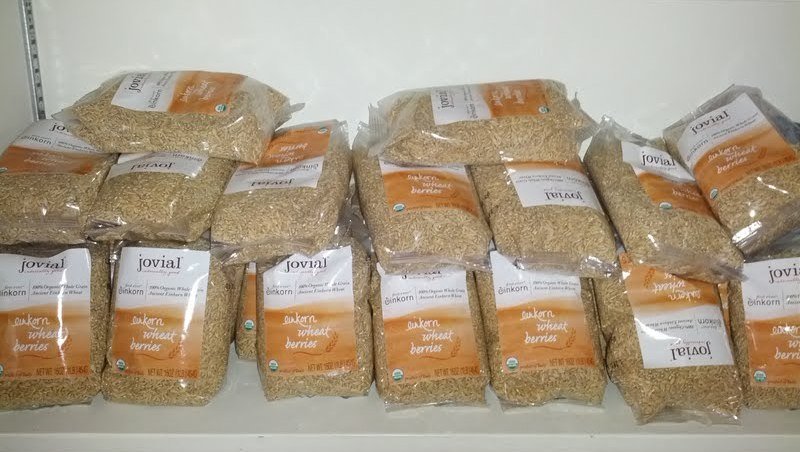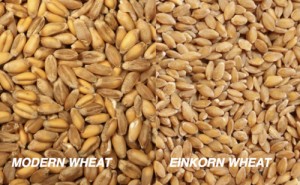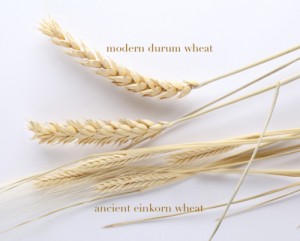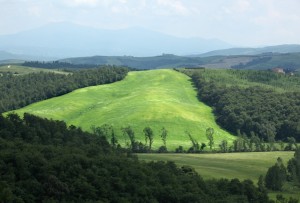Einkorn is the only form of wheat on Earth that is completely unhybridized, containing the good gluten that even sensitive individuals can usually eat. Consuming it has four main benefits.
In my home, I’ve purchased organic white wheat and spelt in bulk for many years. Grinding it into fresh flour is the most nutritious and tastiest way to bake! I also did this to avoid the conventional toxic wheat in North America.
Farmers on this continent frequently desiccate their crops with glyphosate-containing herbicides. This practice is beneficial for ease and speed of harvest.
I credit this approach with my family avoiding any wheat allergies or problems digesting grains in general. This is true provided they are traditionally prepared. Bulgur is an example of this ancestral practice still widely used today.
For those of you who do have wheat issues, you’ll be encouraged to know that my husband used to have allergy and digestive issues with wheat years ago. He no longer does thanks to careful avoidance of wheat for several years, rebalancing the gut with traditional cooking, raw dairy, and the GAPS Diet.
Having a lot of experience dealing with wheat allergies, I can say that there certainly is a huge difference between modern processed wheat, products made with it such as seitan, and what you produce yourself at home.
I remember when I was breastfeeding my youngest child, if I ate so much as a mouthful or two of processed wheat at a restaurant in the form of a sandwich, slice of pizza, or a bread roll, she would spit up for one or sometimes even two days!
If I ate wheat that I ground myself and either sprouted, soaked, or sour leavened, however, she never had any spit up issues. To me, this was a huge testament to the radically improved digestibility of wheat that is prepared using the wise methods of ancestral cultures.
Einkorn Health Benefits over Modern Wheat
Given my success over the years with incorporating traditional methods of wheat preparation in my home, you may be surprised to learn that I’m switching the type I use.
What’s more, I’m switching 100%.
I still have about half of a large bucket of organic spelt to use up and a small amount of organic soft white wheat before the switch is complete. My goal is to have my family completely transitioned to einkorn wheat within another month or two.
Here are the 4 reasons why I am making the wholesale change to einkorn. Note that this strain is not to be confused with farro or heirloom wheat:
#1: Better Taste
My first experience baking with einkorn occurred after I received a thoughtful gift of, among other things, einkorn flour and wheat berries. I was delighted when I ground the einkorn into flour and saw how light and white it was.
I am not a fan of bran and am not of the food philosophy that all that fiber is actually good for you. Folks just think they need a lot of fiber as they are so constipated from all the processed foods they eat! Observing that einkorn, the most ancient and unhybridized form of wheat, has less bran compared with modern wheat was encouraging to me.
I was thrilled to see that my family thoroughly enjoyed the soaked waffles made with fresh einkorn flour. It was my first einkorn dish! Ever since they have asked me to use only that flour.
Like any Mom, I’m a sucker for kids who love my cooking and tell me so on a frequent basis. So, I made the easy decision to switch to einkorn completely for all my home baking.
#2: More Digestible
My husband’s stomach is my canary in the coal mine. If something is not easy to digest, he can tell and lets me know right away. As he has fully recovered from a wheat allergy, he knows which forms of wheat and which preparation methods sit best in his stomach and which do not.
While my properly prepared grain dishes made with wheat or spelt digest fine for him, once he tried the einkorn, he could tell that his digestion was even lighter for the experience. This is possibly because einkorn contains good gluten, different on a molecular level from modern gluten. It is much better tolerated by those with gluten sensitivity.
Better digestion means better absorption of nutrients, so einkorn surpassed the competition in that category.
#3: Einkorn is Visually Different

The first thing I noticed when I ground einkorn into flour for the first time was how much smaller a grain of einkorn is compared with a grain of modern wheat. They are about half the size!
In addition, the telltale crease on one side of a grain of modern wheat is absent from a grain of einkorn. The reason for the differences is that over the centuries, the genetics of wheat gradually changed due to human cultivation practices.
Year after year, farmers selected the seeds at harvest time that suited the goal of higher yields and more gluten. This worked best for big farms and larger-scale agriculture, production, and distribution of wheat products.
#4: Only Unhybridized Wheat on Earth

Einkorn is like most plants in that it is diploid. This means that contains only 2 sets of chromosomes. About 2,000 years after einkorn wheat, nature created emmer via the hybridization of 2 wild grasses. Consequently, emmer has 4 sets of chromosomes. Kamut and durum (bulgur) wheat are both descendants of emmer.
Spelt, an heirloom wheat, is the result of hybridization between cultivated emmer and another wild grass. Thus, it contains six sets of chromosomes. Modern wheat is a descendant of spelt.
Note that while humans extensively hybridized wheat over the millennia, there is currently no genetically modified wheat on the market. In the Western United States, however, test plots of GMO wheat have caused some contamination issues.
As you can see, einkorn is the purest and most ancient form of wheat available. It has only 2 sets of chromosomes with a very different composition of gluten. This form is easier to digest for many with non-genetic gluten intolerance.
Where to Source the Best Quality Einkorn
The only downside of einkorn is that it is not widely available and tends to be more expensive than other types of wheat. It is still quite new to the North American market.
My healthy shopping guide lists sources that I’ve vetted that are fast and affordable to ship to your door. I use these reliable companies myself and have for many years.

The organic einkorn wheat berries from these sources are grown and packaged on one secluded and pristine farm in Tuscany. It is very important to rotate crops on this farm. This is due to the hilly terrain, where yields are low and the land must stay fertile.
What this means is that this particular source of organic einkorn comes from fully pastured fields for five years prior. In addition, soil nutrition is enhanced using one year of crop rotation with the cultivation of chickpeas, lentils or fava beans. This ensures that there is no risk of cross-contamination with other types of grains. Each year’s crop of einkorn comes from truly fertile earth!
Have you tried einkorn wheat yet? If so, what observations have you made about this ancient, unhybridized wheat?
More Information
Sourdough Crackers with Nut Butter
No-Knead Sourdough Bread
Teff Nutrition








I am trying to sprout my einkorn berries I received from Azure. It’s been 4 days – and nothing. Does anyone have any suggestions?
I have a nutrimill. Reply if you are interested.
FYI:
Hi, What kind of grain grinder do you use? And do you have a link to buy one? Thanks! I ordered some Einkorn and am excited!!
I have a nutrimill. Reply if you are interested.
SPROUTING EINKORN – If you try to sprout einkorn grains, and they do not grow, but become mushy – you have dead, old seeds. No life in them. Procure fresh living einkorn seeds from a local farmer!
RED FIFE is a delicious facultative heritage wheat known as Halychanka in Galicia in its region of origin. The Heritage Grain Conservancy offers many more delicious heritage landrace wheats from Europe and the Mideast. They are easy to grow, higher in nutrition and lower in gluten than modern hybrid wheat.
https://sites.google.com/site/loisellema/linkssourcesinfo/hypoallergenic-red-fife
I found this article concerning Red Fife
Compare it to itself! Experiment for yourself! Try baking with einkorn flour to discover for yourself the taste, low-gluten baking quality and nutritional value . I grow many acres of diverse varieties of ancient einkorns that I collected from France, Italy, Germany, Bulgaria, Israel and more. Each has a unique quality. I even crossed the healthiest with the healthiest plants, to create a new local landrace that is well-adapted to New England. There are many more almost-lost ancient grain species that the heritage Grain Conservancy is restoring, esp from the Caucasus Mountains. Eli Rogosa, Heritage Grain Conservancy
Eli..what do you think about Red Fife. It is the only grain I can find up here in Canada. This farmer started growing it a few years back. It is suppose to be really good for people who need to eat gluten free. I find I am still reacting to it though.
https://sites.google.com/site/loisellema/linkssourcesinfo/hypoallergenic-red-fife
Jovial’s Einkorn flour is sifted. Isn’t that the same as the white flour on the grocery store shelves today? All the bran, germ, vitamins and minerals are removed after sifting. That is why we mill our own flour to consume immediately. Also, was wheat soaked in biblical days before making into bread? I am not sure of the purpose of this step before making bread, cookies, etc. Has anyone watched the videos on the BreadBeckers website? http://www.breadbeckers.com They are the reason I started milling my own flour. If anyone knows anything about wheat and milling your own, they sure do! Not once have I seen or heard anything from their recipes or website stating that you need to soak wheat before milling. I am confused!
Einkorn (T. monococcum) is NOT wheat. It has no genetic relationship to T. dicoccoides (wild wheat). Bill Davis is incorrect in grouping einkorn with wheat. Although monococcum is classified within the Triticum tribe, it evolved from wild einkorn – not wild wheat!
from Eli Rogosa, Heritage Grain Conservancy
so if einkorn is not wheat, what is it? What can we compare it to?
Author of wheat belly recommends to stay away from all types of wheat